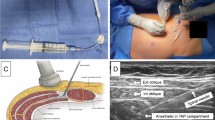Abstract
Purpose
The transversus abdominis plane (TAP) block has been effective in providing adequate pain control, limiting opioid use, and improving perioperative outcomes in patients undergoing major abdominal surgeries. Little is known regarding the efficacy of preoperative (pre-incisional) versus postoperative TAP block in patients who undergo cystectomy.
Methods
This is a retrospective study that reviewed all patients who underwent cystectomy between January 2011 and January 2020 at a single institution. Patients were stratified into three cohorts: preoperative TAP block, postoperative TAP block, no TAP block. A multivariable linear regression model was constructed that assessed factors associated with total morphine milligram equivalents (MME) per hospital stay.
Results
In 463 patients, baseline characteristics were similar. There were 66(14.3%) patients who received a perioperative TAP block, 16 (24.2%) of whom received a preoperative TAP block. There were no significant differences in baseline factors. A TAP block was associated with lower MME used per day (41.8 mg vs 53.1 mg, p = 0.009) and per hospital stay (232 mg vs 320.5 mg, p = 0.001). The median MME per hospital stay and per day was lowest in the preoperative TAP cohort (194.0 mg, p = 0.011 and 38.0 mg, p = 0.042, respectively). On multivariable analysis of a subset of patients who received a TAP block, there was no significant difference in MME use in patients who received a preoperative vs postoperative TAP block (− 84.8, p = 0.339).
Conclusion
The use of TAP blocks was associated with lower MME use in the entire population; however, there was no difference in MME use when comparing preoperative and postoperative TAP blocks.

Similar content being viewed by others
References
National Academies of Sciences, Engineering, and Medicine (2020) Framing opioid prescribing guidelines for acute pain: developing the evidence. The National Academies Press, Washington, DC. https://doi.org/10.17226/25555
Hah JM, Bateman BT, Ratliff J et al (2017) Chronic opioid use after surgery: implications for perioperative management in the face of the opioid epidemic. Anesth Analg 125(5):1733–1740
Edlund MJ, Martin BC, Russo JE et al (2014) The role of opioid prescription in incident opioid abuse and dependence among individuals with chronic noncancer pain: the role of opioid prescription. Clin J Pain 30(7):557–564
Kuo Y-F, Raji MA, Chen N-W et al (2016) Trends in opioid prescriptions among part D medicare recipients from 2007 to 2012. Am J Med 129(2):221.e221-221.e230
Artus M, Laviolle B, Maurice A et al (2014) Risk factors for persistent pain after urological surgery. Annales Françaises d’Anesthésie et de Réanimation 33(5):e89–e94
Melnyk M, Casey RG, Black P et al (2011) Enhanced recovery after surgery (ERAS) protocols: time to change practice? Can Urol Assoc J 5(5):342–348
Vukovic N, Dinic L (2018) Enhanced recovery after surgery protocols in major urologic surgery. Front Med (Lausanne) 5:93–93
Tran DQ, Bravo D, Leurcharusmee P et al (2019) Transversus abdominis plane block: a narrative review. Anesthesiology 131(5):1166–1190
Rafi A (2001) Abdominal field block: a new approach via the lumbar triangle. Anaesthesia 56(10):1024–1026
Hain E, Maggiori L, Prost AIDJ et al (2018) Transversus abdominis plane (TAP) block in laparoscopic colorectal surgery improves postoperative pain management: a meta-analysis. Colorect Dis 20(4):279–287
Matulewicz RS, Patel M, Jordan BJ et al (2018) Transversus abdominis plane blockade as part of a multimodal postoperative analgesia plan in patients undergoing radical cystectomy. Bladder Cancer 4(2):161–167
McDonnell JG, O’Donnell B, Curley G et al (2007) The analgesic efficacy of transversus abdominis plane block after abdominal surgery: a prospective randomized controlled trial. Anesth Analg 104(1):193–197
Baeriswyl M, Zeiter F, Piubellini D et al (2018) The analgesic efficacy of transverse abdominis plane block versus epidural analgesia: a systematic review with meta-analysis. Medicine (Baltimore) 97(26):e11261
De Oliveira Jr. GS, Castro-Alves LJ, Nader A et al (2014) Transversus abdominis plane block to ameliorate postoperative pain outcomes after laparoscopic surgery: a meta-analysis of randomized controlled trials. Anesth Analg 118(2):454–463
Xia J, Paul Olson TJ, Tritt S et al (2020) Comparison of preoperative versus postoperative transversus abdominis plane and rectus sheath block in patients undergoing minimally invasive colorectal surgery. Colorect Dis 22(5):569–580
Amr YM, Amin SM (2011) Comparative study between effect of pre- versus post-incisional transversus abdominis plane block on acute and chronic post-abdominal hysterectomy pain. Anesth Essays Res 5(1):77–82
Funding
This publication (or project) was supported by Grant Number P30 CA015083 from the National Cancer Institute (NCI). Its contents are solely the responsibility of the authors and do not necessarily represent the official view of the NIH.
Author information
Authors and Affiliations
Corresponding author
Ethics declarations
Conflict of interest
The authors declares that they have no competing interest.
Additional information
Publisher's Note
Springer Nature remains neutral with regard to jurisdictional claims in published maps and institutional affiliations.
Supplementary Information
Below is the link to the electronic supplementary material.
Rights and permissions
About this article
Cite this article
Faraj, K.S., Edmonds, V.S., Snider, S.L. et al. Timing of perioperative transversus abdominis plane block at the time of radical cystectomy does not affect perioperative outcomes. Int Urol Nephrol 53, 2019–2025 (2021). https://doi.org/10.1007/s11255-021-02872-0
Received:
Accepted:
Published:
Issue Date:
DOI: https://doi.org/10.1007/s11255-021-02872-0




